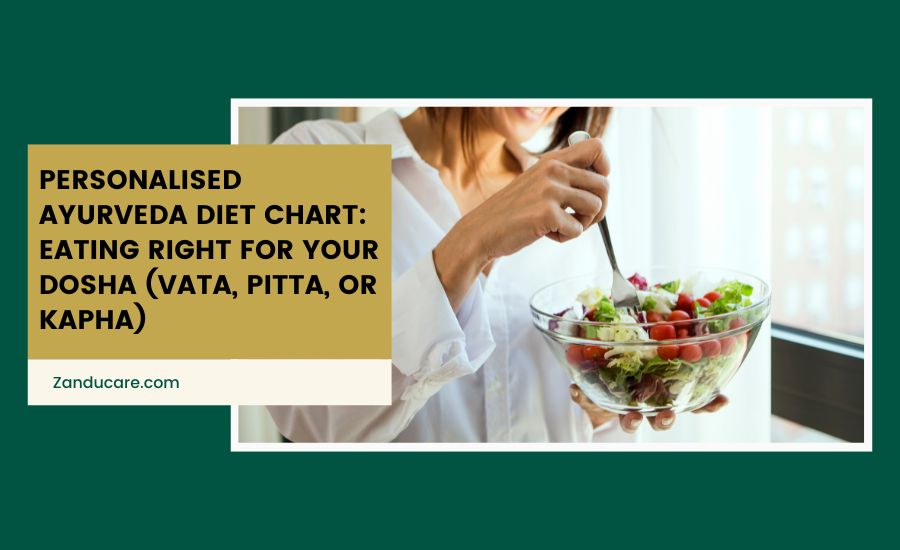|
Key insights:
- Learn how Ayurveda tailors dietary recommendations to your unique body type, or Dosha, for an approach to wellness that resonates with your natural energies.
- Uncover how this ancient Indian health system, based on five natural elements, has guided people for centuries in achieving a harmonious mind-body balance through food.
- Dive into detailed diet charts with specific foods to eat and avoid, tailored to each Dosha, for a practical guide to maintaining physical and emotional balance.
- Discover how this diet goes beyond nutrition by integrating weight management, mindfulness, and preventive health benefits backed by scientific studies.
- See why the Ayurvedic diet emphasises unprocessed, nutrient-rich foods and mindful eating, potentially reducing risks of chronic diseases and improving mental well-being.
|
Ayurveda, the ancient science of health and wellness, believes everyone has a unique body type or “Dosha.” This Dosha affects everything in our lives – from digestion and sleep to mental and emotional balance. The three main Doshas are Vata, Pitta, and Kapha, and each person has one dominant Dosha or a mix of two. Understanding your Dosha can help you choose foods that work best for your body, helping you feel energetic, balanced, and healthy.
|
Did you know:
- A diet rich in sweet, warm foods is ideal for Vata Prakriti. Opt for small meals with ginger, garlic, wheat, black gram, curd, ghee, sesame oil, white gourd, mango, dates, and almonds to support digestion and balance.
- For Vata Prakriti, foods that are dry, cold, and astringent should be avoided, as they disrupt Vata balance.
- For Pitta Prakriti, cooling, dry, sweet, and bitter foods are ideal. Include wheat, green gram, ghee, snake gourd, apple, pomegranate, ripe bananas, old jaggery, coriander, and rock salt to balance Pitta energy.
- For Kapha Prakriti, light, hot, dry, and pungent foods are ideal. Include barley, mustard oil, bitter gourd, lemon, black cumin, dry ginger, and honey to balance Kapha effectively.
|
What is the Ayurvedic Diet?
Ayurveda is an ancient Indian system of holistic medicine. It teaches that the universe consists of five basic elements: air, water, space, fire, and earth. These elements combine in the body to form three energies called doshas. Each dosha controls different body functions. For example, one dosha controls hunger, while another controls body temperature.
The Ayurvedic diet is part of Ayurveda. It is based on figuring out a person's main dosha and eating foods that balance all three doshas. The goal is to promote balance between body and mind. People have followed this way of eating for thousands of years in India.
Diet Chart as per Ayurveda
Here is the diet chart according to Ayurveda:
Diet Chart for Vata Dosha
|
Meal
|
Recommended Foods
|
Avoidable Foods
|
Example Meal
|
|
Breakfast
|
Warm oatmeal, cooked fruits (apples, pears), spices (cinnamon, ginger)
|
Cold cereals, raw fruits, dry or crunchy foods.
|
Oatmeal with warm apples, cinnamon, and a dash of almond milk
|
|
Lunch
|
Root vegetables (sweet potatoes, carrots), whole grains (rice, quinoa), soups
|
Raw salads, beans, cold sandwiches
|
Sweet potato and lentil soup with rice
|
|
Dinner
|
Warm rice, steamed vegetables, a little ghee or olive oil
|
Dry foods, light crackers
|
Steamed veggies with rice and a small spoon of ghee
|
|
Snacks
|
Warm herbal teas, dates, warm milk with spices
|
Chips, popcorn, cold drinks
|
Warm spiced milk with a few dates
|
Diet Chart for Pitta Dosha
|
Meal
|
Recommended Foods
|
Avoidable Foods
|
Example Meal
|
|
Breakfast
|
Smoothies (with cucumber, pears, and coconut water), sweet fruits
|
Spicy foods, sour fruits
|
Smoothie with cucumber, pear, and coconut water
|
|
Lunch
|
Leafy greens, cooling grains (quinoa, barley), cucumbers, dairy
|
Fried foods, tomatoes, vinegar
|
Quinoa salad with cucumber, avocado, and yoghurt dressing
|
|
Dinner
|
Light grains (basmati rice), steamed greens, coconut milk-based dishes
|
Spicy foods, garlic, onions
|
Basmati rice with steamed broccoli and coconut curry sauce
|
|
Snacks
|
Fresh fruit, cucumber slices, herbal mint tea
|
Fried snacks, caffeine
|
Slices of cucumber with a sprinkle of mint
|
Diet Chart for Kapha Dosha
|
Meal
|
Recommended Foods
|
Avoidable Foods
|
Example Meal
|
|
Breakfast
|
Warm apples, ginger tea, light fruits (berries)
|
Heavy foods, dairy, sweetened pastries
|
Warm apple slices with cinnamon and ginger tea
|
|
Lunch
|
Leafy greens, spicy vegetables, whole grains (buckwheat, millet)
|
Creamy soups, red meat, fried foods
|
Lentil soup with steamed kale and buckwheat
|
|
Dinner
|
Lightly stir-fried vegetables, warming spices (black pepper, mustard seeds)
|
Heavy starches, sweets, excessive oil
|
Stir-fried veggies with mustard seeds and brown rice
|
|
Snacks
|
Ginger tea, spicy nuts, herbal teas
|
Sugary snacks, dairy-heavy foods
|
A handful of spiced nuts and ginger tea
|
Advantages of the Ayurvedic Diet for Your Health
Here are some of the benefits of an Ayurvedic diet:
1. Helps in Losing Weight
A small study explored using Ayurvedic diets and yoga to help people lose weight. The diets were customised to balance each person’s Kapha dosha. Kapha relates to body structure and fluid balance. Twelve people did yoga three times per week while following their Ayurvedic diets for 12 weeks. On average, they lost about 8 pounds. They kept losing weight over the next 6 months, for a total of close to 13 pounds lost. However, there was no control group for comparison, so more research is needed.
Meditation can also help with conditions like heart disease and type 2 diabetes. It helps people feel more in control of food and makes eating a more enjoyable experience. So meditation pairs well with Ayurvedic diets.
Together, they promote both physical and mental balance. Customising the Ayurvedic diet to one's dosha and adding yoga and meditation could be beneficial. However, more controlled studies are still needed on this specific combination and approach.
2. Promotes Mindfulness
In the Ayurvedic diet, being mindful is key. Mindfulness means paying close attention to how you feel in the moment. Mindful eating means minimising distractions during meals. Instead, focus completely on each bite's tastes, textures, and scents.
One small 10-person study found mindful eating reduced body weight, depression, stress, and binge tendencies. It may also strengthen self-control and promote a balanced connection to food. Bringing mindful presence to eating allows you to tune into signals for hunger and satisfaction. This introspection can guide healthier choices.
3. Helps in Obesity
A study in 2019 explored using Ayurvedic diets and yoga for weight loss. For 3 months, participants followed an Ayurvedic diet plan. They also practised yoga based on Ayurvedic principles. This was a holistic approach tailored to each person. It addressed both physical and mental health.
By the end of the 3 months, they had lost some weight from the diet and yoga. But the interesting part is that 6 months later, they continued losing weight. On average, participants lost around 13 pounds total over the 6 months.
4. Encourages Whole Foods
The Ayurvedic diet recommends whole, unprocessed foods for optimal health. It advises eating plenty of fruits, vegetables, grains, and legumes, which contain many vitamins, minerals, and fibre that our bodies need. Additionally, the Ayurvedic diet minimises processed foods.
Studies link high processed food intake to higher risks of heart disease, cancer, and even death. Processed foods often lack essential nutrients. So, by focusing on wholesome foods, the Ayurvedic diet may help prevent chronic diseases. However, more research is still needed on this specific diet.
Is the Ayurvedic Diet Safe?
While the Ayurvedic diet may benefit some people, it also has risks to consider. Determining one’s dosha can be challenging since the criteria around body type and health issues are subjective. Additionally, the diet has very strict rules on what to eat and drink and when. For example, there are limits on water intake around meals and detailed food combining guidance.
For some, following such a restrictive and complex diet could be difficult for a long time. Those with a history of disordered eating may be at particular risk. As with any major diet change, expertise is advised. Consult your Ayurvedic expert to assess whether adopting Ayurvedic nutrition principles would be right for you.
Also, do check our other Ayurvedic lifestyle guides:
Conclusion
Finding balance in life is a continuous journey, and Ayurveda offers a beautiful, natural way to achieve it. Understanding your Dosha and making small, mindful changes to your diet can improve your health, digestion, and overall well-being.
Start by making simple adjustments and listening to your body’s responses. In time, you’ll find the unique balance that works best for you. Ayurveda isn’t just a diet – it’s a way to nurture and connect with yourself daily.
FAQs
1. What are some key foods to eat and avoid for the Vata dosha?
Vatas should favour warm, cooked foods and avoid cold, raw, dry, or crunchy foods. Some recommended foods are oatmeal, cooked fruits, root vegetables, and warming spices.
2. What are some benefits of the Ayurvedic diet?
Potential benefits include weight loss, increased mindfulness, help with obesity, and encouraging whole, nutritious foods. It may also help prevent chronic disease.
3. What are some risks or difficulties with the Ayurvedic diet?
Determining one's dosha can be challenging. The strict rules around when and how to eat certain foods may be difficult to adhere to long-term, especially for those with a history of disordered eating.
4. What foods are emphasised in the Ayurvedic diet?
The diet emphasises whole, unprocessed foods like fruits, vegetables, grains, and legumes. It minimises processed foods and customises food choices based on one's dosha.
5. How could the Ayurvedic diet help with weight loss?
In one small study, customised Ayurvedic diets plus yoga helped participants lose up to 13 pounds over 6 months. Mindful eating techniques also aid weight loss.
References:
- A diet rich in sweet, warm foods is ideal for Vata Prakriti. Opt for small meals with ginger, garlic, wheat, black gram, curd, ghee, sesame oil, white gourd, mango, dates, and almonds to support digestion and balance. (https://www.researchgate.net/)
- For Vata Prakriti, foods that are dry, cold, and astringent should be avoided, as they disrupt Vata balance. (https://www.researchgate.net/)
- For Pitta Prakriti, cooling, dry, sweet, and bitter foods are ideal. Include wheat, green gram, ghee, snake gourd, apple, pomegranate, ripe bananas, old jaggery, coriander, and rock salt to balance Pitta energy. (https://www.researchgate.net/)
- For Kapha Prakriti, light, hot, dry, and pungent foods are ideal. Include barley, mustard oil, bitter gourd, lemon, black cumin, dry ginger, and honey to balance Kapha effectively. (https://www.researchgate.net/)










